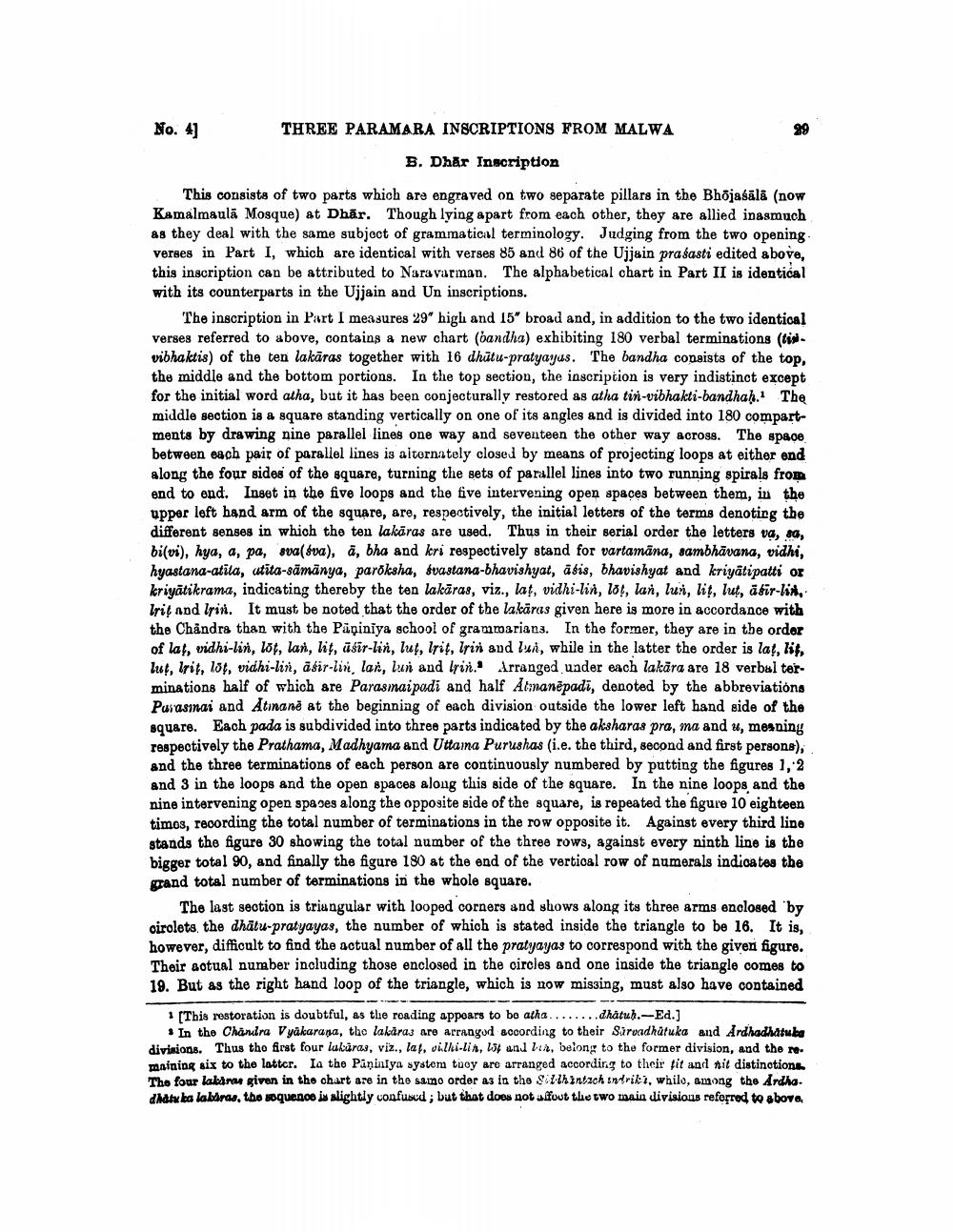________________
No. 41
THREE PARAMARA INSCRIPTIONS FROM MALWA
B. Dhär Inscription
This consists of two parts which are engraved on two separate pillars in the Bhõjaśālā (now Kamalmaulā Mosque) at Dhār. Though lying apart from each other, they are allied inasmuch as they deal with the same subject of grammatical terminology. Judging from the two opening verses in Part I, which are identical with verses 85 and 86 of the Ujjain prasasti edited above, this inscription can be attributed to Naravarman. The alphabetical chart in Part II is identical with its counterparts in the Ujjain and Un inscriptions.
The inscription in Part I measures 29" high and 15" broad and, in addition to the two identical verses referred to above, contains a new chart (bandha) exhibiting 180 verbal terminations (tis. vibhaktis) of the ten lakāras together with 16 dhutu-pratyayus. The bandha consists of the top, the middle and the bottom portions. In the top section, the inscription is very indistinct except for the initial word atha, but it has been conjecturally restored as atha tin-vibhakti-bandhah. The middle section is a square standing vertically on one of its angles and is divided into 180 compartments by drawing nine parallel lines one way and seventeen the other way across. The space between each pair of parallel lines is altornately closed by means of projecting loops at either end along the four sides of the square, turning the sets of parallel lines into two running spirals from end to end. Inset in the five loops and the five intervening open spaces between them, in the upper left hand arm of the square, are, respectively, the initial letters of the terms denoting the different senges in which the ten lakaras are used. Thus in their serial order the letters va, sa, bi(vi), hya, a, pa, sva(sva), à, bha and kri respectively stand for vartamāna, sambhāvana, vidhi, hyastana-atila, utīta-sāmānya, paroksha, svastana-bhavishyat, asis, bhavishyat and kriyatipatti or Ierivātikrama, indicating thereby the ten lakāras, viz., lat, vidhi-lin, log, lan, luri, lit, lut, a dir-. Irit and Irin. It must be noted that the order of the lakaras given here is more in accordance with the Chåndrs than with the Paniniya school of grammarian3. In the former, they are in the order of lat, vidhi-lin, lot, lan, lit, Ūsir-lin, lug, Irig, Irin and Lu, while in the latter the order is lat, lit lut, Irit, lot, vidhi-lir, asir-liv, lar, lun and Irin. Arranged under each lakāra are 18 verbal terminations half of which are Paras mai podi and half Atinanēpadi, denoted by the abbreviations Pusasinai and Atinane at the beginning of each division outside the lower left hand side of the square. Each pada is subdivided into three parts indicated by the aksharas pra, ma and u, mesning respectively the Prathama, Madhyama and Uttaina Purushas (i.e. the third, second and first persons), and the three terminations of each person are continuously numbered by putting the figures 1, 2 and 3 in the loops and the open spaces along this side of the square. In the nine loops and the nine intervening open spaces along the opposite side of the square, is repeated the figure 10 eighteen timos, recording the total number of terminations in the row opposite it. Against every third line stands the figure 30 showing the total number of the three rows, against every ninth line is the bigger total 90, and finally the figure 180 at the end of the vertical row of numerals indicates the grand total number of terminations in the whole square.
The last section is triangular with looped corners and shows along its three arms enclosed by girolets, the dhätu-pratyayas, the number of which is stated inside the triangle to be 16. It is. however, difficult to find the actual number of all the pratyayas to correspond with the giver figure. Their actual number including those enclosed in the circles and one inside the triangle comes to 19. But as the right hand loop of the triangle, which is now missing, must also have contained
· [This restoration is doubtful, as the roading appoars to be atha........dhātuh.--Ed.]
* In the Chandra Vyakarana, the lakaras are arranged according to their Siruadhatuka and Ardhadhatuba divisions. Thus the first four lukuras, viz., lat, vilki-lin, L54 and Lia, belong to the former division, and the re. maining six to the latter. Ia the Paninfya system tooy are arranged according to their fit and nit distinctions The foar lakanu given in the chart are in the samo order as in the Stilhintach undrikz, whilo, among the Ardha. dAdt ba lakiras, the sequence is slightly confused; but that does not affout the two main divisious referred to abova




